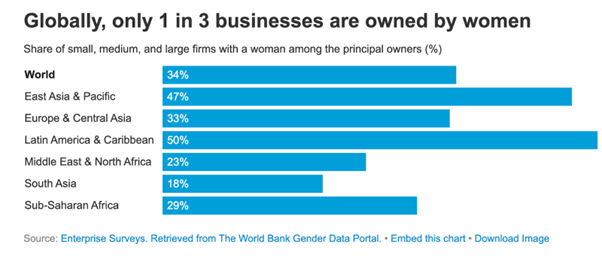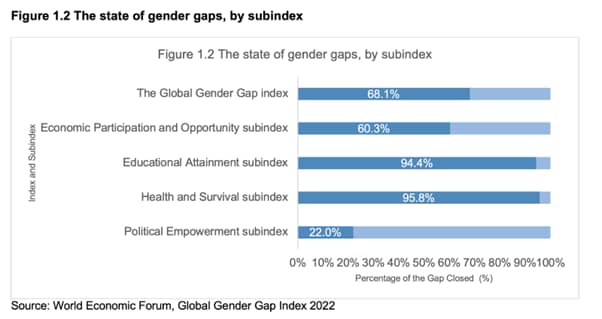Here’s what women’s entrepreneurship looks like around the world
The number of women entrepreneurs is increasing around the world.
Image: Unsplash/Mapbox
Stay up to date:
SDG 05: Gender Equality
Listen to the article
- Women started 49% of new businesses in the US in 2021, up from 28% in 2019, according to a new study.
- Women entrepreneurship is also growing around the world, but obstacles remain and men still outnumber women 3-1 when it comes to business ownership, say experts.
- The World Economic Forum’s Global Gender Gap Report 2022 shows more women than men continue to be impacted by the pandemic.
The number of female entrepreneurs is increasing around the world, but many women continue to face significant obstacles to starting their own businesses.
Here are some key statistics.
A start-ups boom in the US, led by female entrepreneures
Women and entrepreneurs of colour are leading a boom in new business creation in the United States, a new survey has found.
Almost half of start-ups in 2021 were formed by women, according to human resources cloud software company, Gusto.
This is a “dramatic increase” from the 28% of women starting new businesses in 2019, the company says. Seizing a “pandemic related opportunity” was the biggest reason for women starting new businesses in 2021.
Three times more Black or African American entrepreneurs also started businesses. This share has tripled from 3% in 2019 to 9% in 2021.
More than 5.4 million new businesses were created in 2021, setting a new record. It’s particularly impressive that this happened while the country was “in the midst of a once-in-a-century pandemic,” Gusto says in its 2022 survey of new business owners.
Responses from more than 2,600 new business owners were gathered for the survey.
How is the World Economic Forum promoting equity in the workplace?
The rise of UK microbusinesses
The pandemic is also driving changes in entrepreneurship in the UK.
More young people, women and ethnic minorities are starting microbusinesses – companies with fewer than 10 employees.
In its Venture Forward study of 2.3 million microbusinesses in the UK, web domain company GoDaddy has found women are now running almost 40% of UK microbusinesses – up from 32% before March 2020.
Entrepreneurs are also getting younger. Since March 2020, the proportion of under-35s starting businesses has more than doubled, from 16.4% to 34%, the report finds.
And more minorities are starting UK businesses. Black founders grew from 5.4% pre-pandemic to 6.6%, while the share of Asian entrepreneurs has risen slightly from 10.1% before the pandemic to 11.9%.
Accept our marketing cookies to access this content.
These cookies are currently disabled in your browser.
Women entrepreneurs around the world
Female entrepreneurship is also on the rise in developing countries.
Between 8 million and 10 million small and medium-sized enterprises across the developing world have at least one female owner, the World Bank says in its Female Entrepreneurship Resource Point.
Outside of the agricultural sector, about a third of women around the world are self-employed in informal work. This tends to be home-based, small scale and focused on sectors like retail and service.
Working from home helps women “satisfy competing demands for their time”, the World Bank says. This includes “a disproportionate share of housework and childcare responsibilities”.
Some of the obstacles facing women entrepreneurs in developing economies include lack of access to finance and legal inequalities, including restrictions on owning or managing property.
Globally, only one in three businesses are owned by women, according to the World Bank.

Women are working fewer hours
Global data also suggests women continue to be more affected by the pandemic than men.
In its new Global Gender Gap Report 2022, the World Economic Forum notes that women have lost many more working hours than men since the peak of the pandemic.
Caring and homeschooling responsibilities helped to take women away from the workforce. Women have also been more adversely affected by job losses in sectors like hospitality and retail.
As a result, women’s participation in the workforce has fallen: from 60.1% in the 2021 edition of the Forum’s 146-country report to 51.7% this year.
Higher wages for women
Wage equality increased marginally for women in 2022, this year’s report finds. This is because women are earning 2% more on average than they did in 2021, while men are earning 1.8% less than last year.
The report estimates it will still take 151 years to close the global gender gap in women’s economic opportunity and attainment. This is a major improvement on last year’s economic gap of more than 260 years – but the gap remains far too big, the Forum says.

More women in technical roles
One positive trend highlighted in the Global Gender Gap Report 2022 is a change in the kind of roles women are taking on.
The data shows women’s share of professional and technical roles has increased by 6.7 percentage points.
There are also more women in senior, legislative and managerial roles. This share is up by 5.4 percentage points.
Togo in West Africa has the highest number of women in senior roles, at 70.1%, while in Belarus in Eastern Europe, 70% of women are in professional and technical roles.
Accept our marketing cookies to access this content.
These cookies are currently disabled in your browser.
Don't miss any update on this topic
Create a free account and access your personalized content collection with our latest publications and analyses.
License and Republishing
World Economic Forum articles may be republished in accordance with the Creative Commons Attribution-NonCommercial-NoDerivatives 4.0 International Public License, and in accordance with our Terms of Use.
The views expressed in this article are those of the author alone and not the World Economic Forum.
Forum Stories newsletter
Bringing you weekly curated insights and analysis on the global issues that matter.
More on Jobs and the Future of WorkSee all
Navi Radjou
May 8, 2025
Naoko Tochibayashi and Mizuho Ota
May 5, 2025
Shuvasish Sharma and Ximena Játiva
May 1, 2025
Ricky Li and Ximena Játiva
May 1, 2025
Ana Mahony
April 30, 2025






